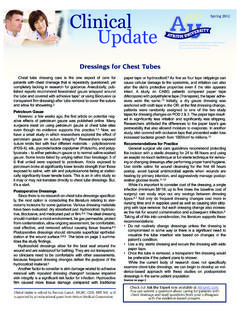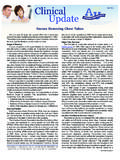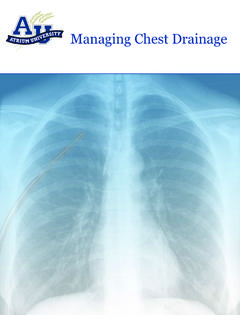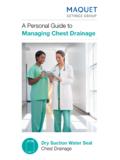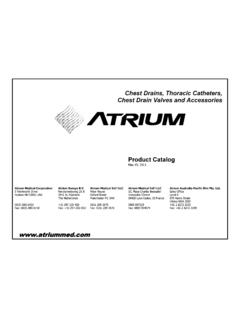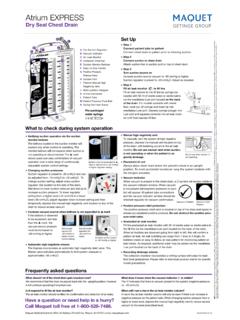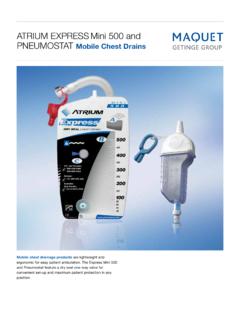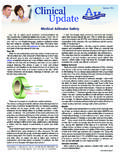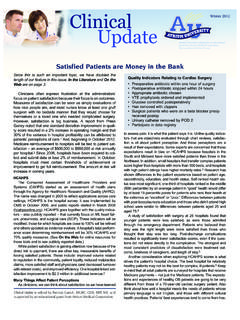Transcription of Evidence-Based Care of Patients with Chest Tubes …
1 Evidence-Based care of Patients with Chest Tubes 2013 AACN National Teaching Institute Evidence-Based care of Patients with Chest Tubes 2013 American Association of Critical- care Nurses National Teaching Institute Boston, MA May 20-23, 2013 Speaker: Patricia Carroll RN-BC, RRT, MS Adjunct Faculty, School of Health Sciences Excelsior College Owner, Nurse s Notebook, LLC Evidence-Based care of Patients with Chest Tubes 2013 AACN National Teaching Institute Page 2 Table of Contents Objectives .. 3 Disclosure .. 3 About the Speaker .. 3 Developing Policies and Procedures .. 4 Literature Review .. 5 Chest Drain Suction .. 6 Chest Tube Manipulation .. 9 Chest Tube Clearance .. 9 Imaging .. 10 Chest Tube Dressings .. 11 Negative Pressure .. 12 Chest Tube Removal Criteria.
2 13 Post Removal Imaging .. 15 References .. 17 Resources .. 20 Annotated Nursing Literature on Chest Drainage .. 20 Literature Reviews by Speaker .. 23 Additional Annotated References .. 23 Resources on Policies and Procedures / evidence Searching .. 28 Evidence-Based care of Patients with Chest Tubes 2013 AACN National Teaching Institute Page 3 Objectives After attending this session, learners should be able ..compare traditional practices with Evidence-Based practices ..develop Evidence-Based standards of practice for Patients with Chest Tubes Disclosure Pat Carroll designs educational materials for Atrium Medical Corporation. About the Speaker Pat Carroll, a registered nurse and registered respiratory therapist, published her first article on caring for Patients with Chest drainage in 1986 and has been educating nurses on proper care of these Patients ever since.
3 Pat has clinical experience in adult and pediatric emergency and critical care , general medical-surgical and home care . She designed and taught a registered nurse re-entry program, has served on advisory boards of respiratory therapy and radiologic technology schools, and has taught in nursing and respiratory therapy programs in Connecticut and New York. A multi-award winning author, Pat has written more than 100 peer-reviewed articles in the nursing literature, and 4 books, including an AJN Book of the Year. She is a contributor to the Evidence-Based guides at Until she decided to stop traveling in 2005, Pat spoke at 20 consecutive NTIs. She is currently an adjunct professor in the School of Health Sciences at Excelsior College, where she teaches online courses with students all over the world, including those deployed in the Armed Forces.
4 She continues to write and design educational programs for medical manufacturers. Evidence-Based care of Patients with Chest Tubes 2013 AACN National Teaching Institute Page 4 Developing Policies and Procedures Evidence-Based policies and procedures reflect translating research into practice and are associated with improved outcomes of care . The Magnet model emphasizes the importance of integrating new knowledge, innovation and improvements in nursing practice. Despite the clear benefits of Evidence-Based practice, there are also barriers to developing and implementing these policies and procedures. Evidence-Based care of Patients with Chest Tubes 2013 AACN National Teaching Institute Page 5 Literature Review For the topics in this presentation, topics are rated in one of four ways: Strong guidance: multiple studies generally agree Equivocal: multiple studies, disagreement without clear advice Avoid: multiple studies agree with avoiding an action or approach No information: no research in this area Evidence-Based care of Patients with Chest Tubes 2013 AACN National Teaching Institute Page 6 Chest Drain Suction No research supports -20 cmH2O as an optimal level of suction.
5 3 Has been used for at least 50 years and is recommended by experts as safe initial setting. Many studies have examined whether suction is the best approach after lung resection or other thoracic procedures. Outcomes include Air leak duration Time with Chest tube Hospital length of stay (LOS) Evidence-Based care of Patients with Chest Tubes 2013 AACN National Teaching Institute Page 7 Recommendation In routine cases, limited or no suction resulted in reduced time with tube, and reduced length of stay. 4-9 Okamoto noted increased fluid drainage in Patients using suction and questioned if this was due to pleural irritation, and not better drainage Concerns about using suction with air leaks center around concept that suction pulls air through air leak, preventing tissues from coming together to heal.
6 Recent questions raised by researchers: Is apparent pneumothorax on CXR a true pneumothorax resulting from air leak, or is it Pleural dead space or apical deficit Atelectasis from small airway obstruction Is a residual pneumothorax less risky than keeping a tube in and one attached to suction? Evidence-Based care of Patients with Chest Tubes 2013 AACN National Teaching Institute Page 8 When evaluating this research: Did the gravity group ever use suction? (Many are placed on suction in OR / PACU; gravity doesn t start till return to unit) What determines when suction is stopped? What is the suction level? What outcomes were considered? o Air leak o Residual pneumothorax on CXR o Number of Chest tube days o Hospital LOS Management options Stop suction when no bubbling in water seal No suction during the day, at night apply suction to drain (-10 cmH2O) 4,5,10 Bertholet (2011)2 Initially suction at -10 cmH2O for one hour postop, then if CXR shows < 25% pneumothorax, suction turned off Evidence-Based care of Patients with Chest Tubes 2013 AACN National Teaching Institute Page 9 Chest Tube Manipulation Classic research discovered pressures as low as -400 cmH2O with Chest tube stripping11,12 Recommendation Do not strip or milk Chest Tubes .
7 Other manipulation: milking, fan-folding, tapping are not standardized in any way, so difficult to compare research. Overall, tubing manipulation does not improve drainage of fluid from the A survey showed 71 % of nurses state stripping not allowed, but 74% of surgeons were in favor of it18 Question from research: Is increased amount of fluid produced in response to milking Chest Tubes actually from tissue irritation and trauma and not from improved physics of normal fluid drainage?19 Chest Tube Clearance Key is positioning drainage tubing to use physics principles and facilitate fluid drainage. Dependent loops containing fluid can completely block fluid drainage within 30 minutes and change pleural pressures from -18 cmH2O to + 8 cmH2O, a change of 26 cmH2O in pressure20-22 Evidence-Based care of Patients with Chest Tubes 2013 AACN National Teaching Institute Page 10 Recommendation Avoid fluid-filled dependent loops in Chest drainage ,18,23 If impossible to avoid, lift and drain at least every 15 minutes to maintain drainage.
8 Question on research: When evaluating tube clearing devices, consider if they reduce nursing time that must be devoted to tube maintenance or if they make care more complicated. Imaging What is the best way to see a pneumothorax? CT is considered gold standard Pneumothorax not seen on radiograph, but seen on CT is called occult pneumothorax24,25 Ultrasound is emerging as a reliable tool in experienced hands with detection rates generally as good as CXR,24- Evidence-Based care of Patients with Chest Tubes 2013 AACN National Teaching Institute Page 11 27 and in one study, approaching CT Thinking about occult pneumothorax How many critically ill Patients are not able to have CT scans? How many Patients have we been treating over the years that had these pneumothoraces, but without CT, they were not detected?
9 29 Ultrasound much quicker and at no additional cost to the patient, but dressings and subcutaneous air block imaging26 To detect malpositioning, 3D imaging of CT is much more effective than portable CXR25 Question on research: Keep in mind that portable CXR may miss as much as 17% of pneumothorax25 Chest Tube Dressings No research has been done on Chest tube dressings, particularly the use of petroleum gauze around the Chest tube.* In one study, knots were tied in 4 different types of suture material, then wrapped in gauze with saline Evidence-Based care of Patients with Chest Tubes 2013 AACN National Teaching Institute Page 12 or More knots exposed to petroleum untied and failed at a lower tensile strength than saline-exposed knots. Otherwise, some principles can be taken from research done on dressings for CABG *At NTI, a poster presentation described a study of 4361 thoracotomy Patients .
10 Neither air leaks nor wound infections were attributable to dressing materials. The researchers use and recommend a simple dry occlusive gauze dressing. Jeffries M, C Gryglik, D Davies, S Knoll. Chest tube dressings: outcomes of taking petroleum- based dressings on air leak and infection rates. Poster presentation. National Teaching Institute. Boston, MA: American Association of Critical- care Nurses; 2013. Negative Pressure We typically worry about positive pleural pressure and risks from pneumothorax, but there is increasing appreciation of risks from negative pressure. Damage in ARDS / Acute lung injury (ALI) is caused by the transpulmonary pressure gradient: the difference between the pressure in the alveoli and outside the alveoli. with positive Evidence-Based care of Patients with Chest Tubes 2013 AACN National Teaching Institute Page 13 Oldfield (2009)1 determined that the risk of any hospital-acquired infection was directly related to number of Chest tube days.
